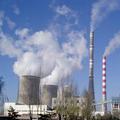 加州大學經濟學者最新的分析發現,中國主要溫室氣體二氧化碳排放的成長量,遠大於先前的預測。這使得穩定大氣溫室氣體濃度的目標更難達成。
加州大學經濟學者最新的分析發現,中國主要溫室氣體二氧化碳排放的成長量,遠大於先前的預測。這使得穩定大氣溫室氣體濃度的目標更難達成。
這份研究的作者是加州柏克萊大學農業與資源經濟學的助理教授歐夫翰默(Maximillian Auffhammer)和加州聖地牙哥大學經濟學教授卡森(Richard Carson)。他們根據中國30個省份的污染排放資料所發現的結論。
歐夫翰默表示,這項研究就像一記警鐘,挑戰了「只要富裕的工業化國家有所行動,就足以達到穩定大氣二氧化碳濃度目標的有效策略」的信念。歐夫翰默說:「現在,將中國和及其他開發中國家全部整合併入未來的氣候變遷協議中,將變得更加重要。」
根據預測指出,包括聯合國跨政府氣候變遷小組(IPCC)先前所引用過的數據顯示,包含中國在內的區域從2004年到2010年間的二氧化碳排放成長率約為2.5 - 5%。但加州大學此一新研究卻將同時期的中國二氧化碳排放成長率訂為至少11%。這份研究已經在網路上公開,並將登刊於5月號的《環境經濟與管理期刊》。
研究人員所做的最保守預估是,直到2010年,中國的碳排放將比2000年水準高出6億噸。單單中國碳排放量的成長,將使得京都議定書中所有已發展國家所共同承諾的1億1千6百萬噸的碳減量,變得微不足道。在2006年之前,未加入京都議定書的美國,一直都是全球最大的二氧化碳排放國;現在,中國已經取而代之。
科學家以往都是根據區域或國家的化石燃料消耗量來計算二氧化碳排放量。接著再利用現行的模型,考量人口數、社會富裕程度、科技發展等因素,推估溫室氣體排放的成長量。加州大學的研究人員解釋中國二氧化碳排放量與先前預測值的驚人差異是因為,研究人員的分析採樣是使用中國的省級資料,因此可以取得到2004年為止,整個國家較詳細的排放數據。
 卡森說:「大家都把中國視為單一國家,但其實中國的任何一個省,不論在土地面積或人口上,都比許多歐洲國家來得大且多。」在中國,化石燃料的消耗量並未回報於省級政府,因此,研究人員利用從中國環保行政單位取得的廢氣排放量,來代表CO2排放量。卡森表示:「中國的排放大約在2000年時發生了值得注意的轉變。當時美國批淮京都議定書的希望越來越渺茫,國際社會轉向中國要求減量之際。中國的能源使用成長速度開始大於所得的成長,且大部份的能源使用是沒有效率的。」
卡森說:「大家都把中國視為單一國家,但其實中國的任何一個省,不論在土地面積或人口上,都比許多歐洲國家來得大且多。」在中國,化石燃料的消耗量並未回報於省級政府,因此,研究人員利用從中國環保行政單位取得的廢氣排放量,來代表CO2排放量。卡森表示:「中國的排放大約在2000年時發生了值得注意的轉變。當時美國批淮京都議定書的希望越來越渺茫,國際社會轉向中國要求減量之際。中國的能源使用成長速度開始大於所得的成長,且大部份的能源使用是沒有效率的。」
研究者同時指出,在2000年後,中國中央政府開始將興建新電廠的責任轉到到省級政府,但省府官員並沒有足夠的誘因,也沒有足夠的資源興建乾淨、有效率的電廠,這類電廠雖然興建時較貴,但長期運轉下來是較為省錢的。卡森又說:「政府官員在擴增發電設備時,並不是考量能源效率,而是越快越好,或越便宜越好。較富裕的沿海省份因為可取得最好的技術,能夠興建較乾淨的發電廠。但很多貧窮的內陸省份還在使用1950年代前蘇聯時代的低效率技術。」
卡森表示:「問題在於,電廠一旦興建就可以使用40-75年,這些省級官員等於是把自己鎖在長期的排放軌道裏,比人們所預期的排放量還要高。我們的預估值也考量了中國充斥著不淨潔且低效率電廠的事實。」
The growth in China's emissions of the primary greenhouse gas carbon dioxide, CO2, is far greater than previous estimates, making the goal of stabilizing atmospheric greenhouse gases much more difficult, finds a new analysis by economists at the University of California.
The authors of the study, Maximillian Auffhammer, UC Berkeley assistant professor of agricultural and resource economics, and Richard Carson, UC San Diego professor of economics, based their findings upon pollution data from China's 30 provincial entities.
Auffhammer said the study should serve as an alarm challenging the belief that actions taken by the wealthy, industrialized nations alone represent a viable strategy towards the goal of stabilizing atmospheric concentrations of carbon dioxide.
"Making China and other developing countries an integral part of any future climate agreement is now even more important," said Auffhammer.
Previous estimates, including those used by the Intergovernmental Panel on Climate Change, say the region that includes China will see a 2.5 to five percent annual increase in CO2 emissions between 2004 and 2010. The new University of California analysis puts that annual growth rate for China to at least 11 percent for the same time period.
The study is scheduled for print publication in the May issue of the "Journal of Environmental Economics and Management," but is now online.
The researchers' most conservative forecast predicts that by 2010, there will be an increase of 600 million metric tons of carbon emissions in China over the country's levels in 2000. This growth from China alone would dramatically overshadow the 116 million metric tons of carbon emissions reductions pledged by all the developed countries in the Kyoto Protocol. The protocol was never ratified in the United States, which was the largest single emitter of carbon dioxide until 2006, when China became the largest emitter.
Researchers traditionally calculate the CO2 emissions for a region or country from data on fossil fuel consumption. Existing models then use those emission figures and factor in such variables as population size, a society's affluence and technology developments to forecast the growth of greenhouse gas emissions.
In explaining the startling differences in results from previous estimates for China's carbon emissions growth, the UC researchers point out that they used province-level figures in their analysis to obtain a more detailed picture of the country's CO2 emissions up to 2004.
"Everybody had been treating China as single country, but each of the country's provinces is larger than many European countries, both in geographic size and population," said Carson.
Since data on fossil fuel consumption is not reported at the province level in China, the researchers used waste gas emissions, available from China's state environmental protection administration reports, as a proxy for CO2 emissions in this paper.
"A notable shift occurred in China around the year 2000, around the time when hope for an agreement with the U.S. on the Kyoto Protocol began to diminish along with external pressure for China to reduce its emissions," said Carson. "Energy use started to grow faster than income, and much of the energy that was used wasn't efficient."
The authors also pointed out that after 2000, China's central government began shifting the responsibility for building new power plants to provincial officials who had less incentive and fewer resources to build cleaner, more efficient plants, which save money in the long run but are more expensive to construct.
"Government officials turned away from energy efficiency as an objective to expanding power generation as quickly as they can, and as cheaply as they can," said Carson. "Wealthier coastal provinces tended to build clean-burning power plants based upon the very best technology available, but many of the poorer interior provinces replicated inefficient 1950s Soviet technology."
"The problem is that power plants, once built, are meant to last for 40 to 75 years," said Carson. "These provincial officials have locked themselves into a long-run emissions trajectory that is much higher than people had anticipated. Our forecast incorporates the fact that much of China is now stuck with power plants that are dirty and inefficient."
全文及圖片詳見:ENS





